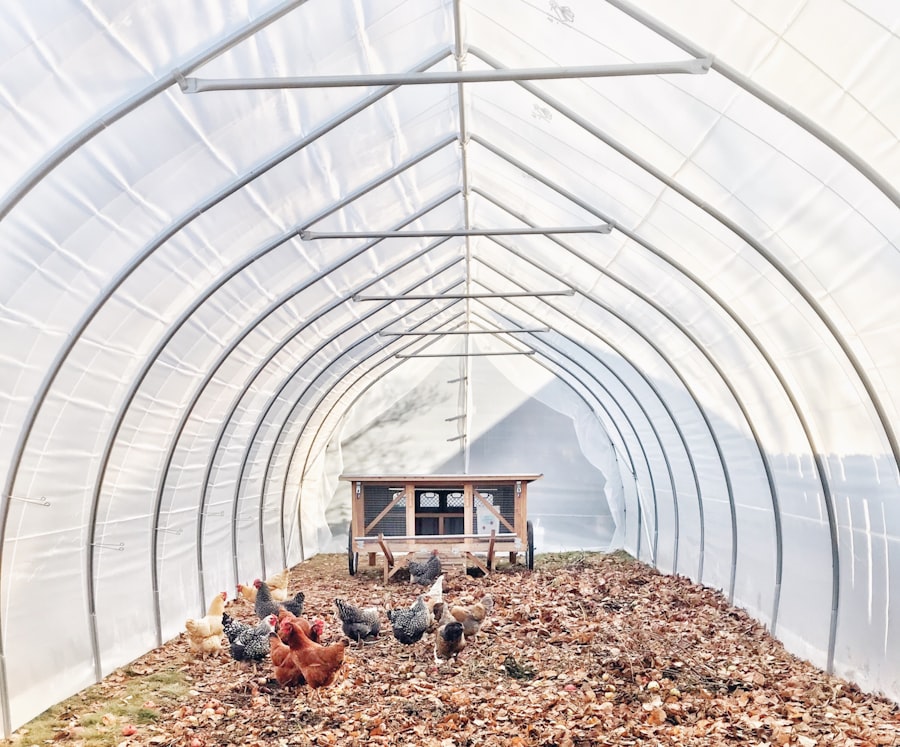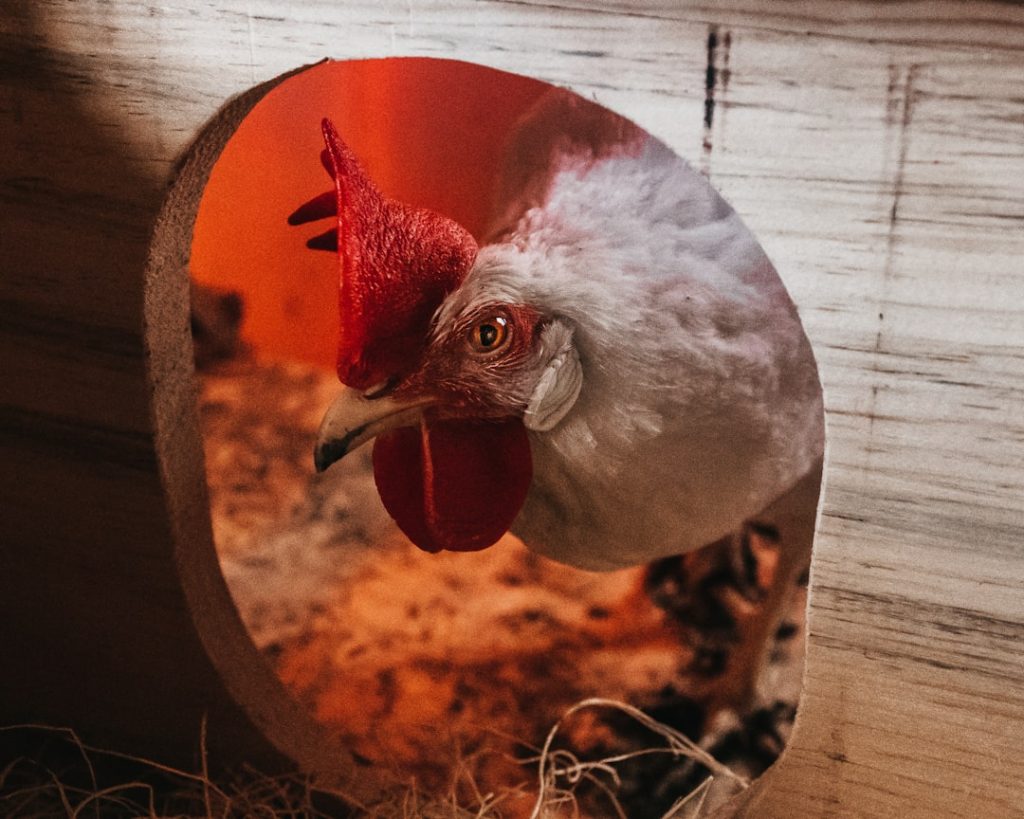Chickens are social creatures with natural instincts to roam and forage. They exhibit curiosity but can be easily startled by sudden movements or loud noises. Understanding these behaviors is essential for preventing escapes.
Providing a secure, spacious environment that resembles their natural habitat can reduce escape attempts. Chickens are diurnal, being most active during daylight hours, which is important to consider when planning their care and supervision. These birds have a strong roosting instinct, seeking elevated and safe sleeping spots at night.
Incorporating adequate roosting space in coop design can keep chickens content and less prone to escape. As prey animals, chickens are constantly vigilant for potential threats. By comprehending their natural behaviors and instincts, owners can create an environment that satisfies their needs and minimizes the risk of escape.
Table of Contents
Key Takeaways
- Chickens have natural behaviors such as scratching, dust bathing, and roosting that should be accommodated in their living environment.
- A secure and spacious coop is essential to provide chickens with a safe and comfortable living space.
- Clipping the wings of chickens can prevent them from flying over fences and escaping.
- Barriers and fencing can be used to prevent chickens from escaping and to protect them from predators.
- Providing enrichment and distractions such as perches, toys, and foraging opportunities can keep chickens entertained and reduce the likelihood of escape.
- Regularly checking for potential escape routes and reinforcing coop security is important to prevent chickens from escaping.
- Training and socializing chickens can help them become more comfortable and less likely to try to escape.
Providing a secure and spacious coop
Building a Sturdy and Predator-Proof Coop
The first line of defense against chicken escapes is a secure and spacious coop. The coop should be constructed with sturdy materials and have a solid foundation to prevent predators from digging underneath. Additionally, the coop should have a secure door that can be locked at night to keep the chickens safe from predators and prevent them from wandering off.
Providing Adequate Space and Comfort
It’s also important to provide adequate space for the chickens to move around and roost comfortably, as overcrowding can lead to stress and potentially increase the likelihood of escape attempts. In addition to a secure structure, the coop should also have proper ventilation and lighting to ensure the chickens’ health and well-being.
Importance of Ventilation and Lighting
Adequate ventilation helps regulate temperature and prevent moisture buildup, which can lead to respiratory issues in chickens. Proper lighting can help maintain a consistent egg-laying schedule and reduce stress in the flock.
Creating a Comfortable and Safe Environment
By providing a secure and spacious coop that meets the chickens’ needs, you can create a comfortable and safe environment that reduces the likelihood of escape.
Clipping the wings of the chickens

One method of preventing chickens from escaping is by clipping their wings. This involves trimming the primary feathers on one wing to prevent the chicken from achieving lift and flying over barriers. It’s important to note that wing clipping should be done carefully and with proper guidance to avoid causing any harm or discomfort to the chicken.
When done correctly, wing clipping can be an effective way to limit the chickens’ ability to fly and reduce the risk of escape. It’s important to keep in mind that wing clipping is not a permanent solution, as the feathers will eventually grow back. Regular maintenance may be required to keep the chickens’ wings clipped and prevent escape attempts.
Additionally, wing clipping should be done in conjunction with other preventative measures, such as providing a secure coop and using barriers or fencing to further deter escape. By carefully considering the pros and cons of wing clipping and seeking guidance from experienced poultry professionals, you can make an informed decision on whether this method is suitable for your flock.
Using barriers and fencing to prevent escape
Another effective way to prevent chickens from escaping is by using barriers and fencing around their coop and outdoor area. This can help create a physical boundary that deters the chickens from wandering off or getting into areas where they shouldn’t be. When choosing fencing materials, it’s important to select options that are sturdy and tall enough to prevent the chickens from flying or jumping over.
Additionally, the fencing should be buried into the ground to prevent predators from digging underneath and gaining access to the coop. In addition to traditional fencing, electric fencing can also be an effective deterrent for preventing escape. Electric fencing delivers a mild shock when touched, which can help discourage chickens from attempting to fly or climb over the barrier.
It’s important to follow safety guidelines and regulations when installing electric fencing to ensure it is used responsibly and does not cause harm to the chickens. By using barriers and fencing strategically around the coop and outdoor area, you can create a secure environment that reduces the likelihood of escape.
Providing enrichment and distractions
Chickens are intelligent animals that benefit from mental stimulation and enrichment activities. By providing distractions and opportunities for natural behaviors, you can help keep them content and less likely to attempt an escape. Enrichment activities can include providing toys, perches, and objects for pecking and scratching.
Additionally, allowing access to a variety of natural materials such as branches, logs, and grass can provide opportunities for foraging and exploration. Another way to provide enrichment is by offering treats and food puzzles that encourage problem-solving and engagement. This can help keep the chickens occupied and reduce boredom, which may lead to escape attempts out of curiosity or restlessness.
By providing enrichment and distractions in their environment, you can help fulfill their natural behaviors and reduce the likelihood of escape.
Regularly checking for potential escape routes

Regular Inspections: The Key to Prevention
To prevent chickens from escaping, it’s essential to regularly inspect their environment for any potential escape routes or weak points in their enclosure. This can include checking for gaps in fencing, loose panels on the coop, or areas where predators may be able to gain access. By conducting routine inspections, you can identify any issues early on and take proactive measures to address them before they become a problem.
Monitoring Chicken Behavior
In addition to physical inspections, it’s also crucial to monitor the behavior of the chickens for any signs of restlessness or attempts at escape. This can help you identify any potential issues with their environment or housing that may need attention.
Maintaining a Secure Environment
By staying vigilant and regularly checking for potential escape routes, you can help maintain a secure environment for your flock. This proactive approach will give you peace of mind, knowing that your chickens are safe and secure.
Training and socializing your chickens can also play a role in preventing escape attempts. By spending time with your flock and establishing trust, you can help reduce their stress levels and build a stronger bond with them. This can make them less likely to attempt an escape out of fear or anxiety.
Additionally, training your chickens to come when called or respond to certain cues can help you manage their behavior and prevent them from wandering off. Socializing your chickens with other flock members can also help reduce stress and prevent escape attempts. Chickens are social animals that thrive in a group setting, so providing opportunities for interaction with other chickens can help keep them content and less likely to try to escape.
By investing time in training and socializing your flock, you can help create a harmonious environment that reduces the likelihood of escape. In conclusion, understanding the natural behavior of chickens is essential in preventing escape attempts. By providing a secure and spacious coop, using barriers and fencing, providing enrichment and distractions, regularly checking for potential escape routes, clipping wings if necessary, and training and socializing your flock, you can create a safe environment that reduces the likelihood of escape.
With careful planning and proactive measures, you can help ensure the well-being of your chickens while minimizing the risk of escape.
If you’re looking for tips on how to keep chickens from taking off, you may also be interested in learning about what to feed ducks. Check out this article for helpful information on keeping ducks and providing them with the right nutrition.
FAQs
What are some methods to keep chickens from flying away?
Some methods to keep chickens from flying away include clipping their flight feathers, providing a covered run, and using netting or fencing to prevent them from escaping.
How can clipping flight feathers help prevent chickens from flying away?
Clipping the flight feathers on one wing of a chicken can help prevent them from achieving lift and flying away. This is a temporary and painless method that allows the chicken to still move around and exercise.
What are the benefits of providing a covered run for chickens?
Providing a covered run for chickens can help prevent them from flying away while still allowing them to have access to outdoor space. This can also protect them from predators and provide shelter from the elements.
How can netting or fencing be used to keep chickens from taking off?
Netting or fencing can be used to create a secure enclosure for chickens, preventing them from flying away. It is important to ensure that the netting or fencing is tall enough and secure enough to prevent the chickens from escaping.
Meet Walter, the feathered-friend fanatic of Florida! Nestled in the sunshine state, Walter struts through life with his feathered companions, clucking his way to happiness. With a coop that’s fancier than a five-star hotel, he’s the Don Juan of the chicken world. When he’s not teaching his hens to do the cha-cha, you’ll find him in a heated debate with his prized rooster, Sir Clucks-a-Lot. Walter’s poultry passion is no yolk; he’s the sunny-side-up guy you never knew you needed in your flock of friends!








